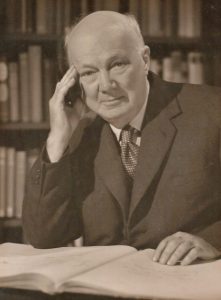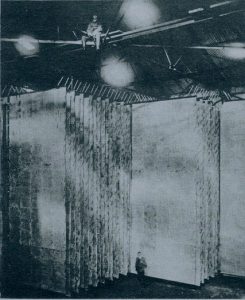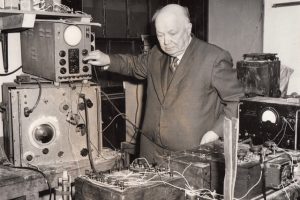Henry Joseph Round, unrecognised electronics pioneer
by WJ Baker 18 May 1966
Nearly 50 years ago, on 31 May 1916, the Battle of Jutland was fought. This encounter has passed into the history books, not only because of its profound influence on the outcome of the Great War, but also on account of its epic scale and ferocity.
But Jutland is historic in another respect, for it was the first sea battle in which the use electronics played a dominant part. If there had been no electronics there would have been no Battle of Jutland.
The secret of how this came about was closely guarded until the end of the war. Then, in 1920, Admiral Sir Henry Jackson, who had been First Sea Lord In 1916, disclosed that the man primarily responsible for bringing the event to pass was a certain Captain HJ Round.
It happened in this manner: for the first two years of the war the British navy had failed to bring the German fleet to decisive battle because of a lag in communications. The Germans had made brief forays into the North Sea, but always by the time the Admiralty had learned about one of these and the Grand Fleet had put out to intercept, the enemy was again snug in harbour.
But, unknown to the Germans, a network of sensitive direction-finding stations had been erected at various sites in the British Isles, and these were not only proving their value in tracking Zeppelin raids and submarine movements, but also for establishing the positions of German surface warships, by taking bearings on their wireless telegraphy transmissions.
At that time the German Navy, when in home waters, used low-power transmission freely, confident that the signals could not be picked up in Britain. But thanks to Round’s development of amplifiers of unprecedented sensitivity this was a false premise.
Then on 30 May 1916, the DF stations reported that a German warship lying at Wilhelmshaven, 300 miles away, was unusually prolific with her wireless signals. That same afternoon it was further noted by the stations that the vessel had left wilhelmshaven and was now lying in the River Jade, about seven miles away from her original station – shown by a change in bearing of less than 1.5°.
The Admiralty reasoned from this information that she was about to put to sea and that the incessant chatter of her wireless telegraphy had constituted sailing orders to other warships.
It was the opportunity the Naval authorities had been looking for: the chance to get into a favourable position in time to strike. The Grand Fleet was ordered to put to sea with all haste and make for the German Bight, and on the following day the German Navy was brought to battle. Electronics had made this possible.
The direction-finding equipment, which used soft ‘C’ valves and a modified Bellini-Tosi directional system, had been developed by HJ Round, of the Marconi Company at Broomfield, Chelmsford, just before the war.
It was not long before Round’s work came to the notice of the War Office, and on the outbreak of hostilities, he was seconded to Intelligence and ordered to provide an initial two stations for service in France.
This was speedily done and, following the success of these, a network, covering the entire Western Front, evolved. Further stations in Britain were also commissioned, Round being recalled from France to be responsible for these.
Naval vessels were also fitted with DF equipment. One of Round’s inventions in connection with its use on ships was a quadrantal error-correcting device.
But these are only wartime incidents in a career studded with no fewer than 117 patent applications, which included his British patent for the use of the thermionic valve as a generator of continuous-wave oscillations, and those on the screened grid and RF pentode valves which revolutionised receiver design in the mid-1920s.
Henry Joseph Round was born on 2 June, 1881, at Kingswinford, Staffordshire. His early education took place at Cheltenham, but later he studied at the Royal College of Science, gaining first-class honours.
In 1902 he joined the Marconi Company and was sent to America where, he recalls, his office junior was a youngster by the name of David Sarnoff, now chairman of the Radio Corporation of America and internationally famous. (RCA stemmed from the American Marconi Company).
His next assignment was to the Marconi Training School at Babylon, Long Island, New York, where wireless operators were trained. But Round’s inventive spirit was already quickening, and whenever possible he enlivened his official duties and his spare time with investigations into some of the problems of wireless reception and transmission.
At this time (1903-4) he carried out experimental work on dust cores for tuning inductances and also conducted various transmission and reception tests over land and sea, using various frequencies.
He also experimented with directional frame antennae and combined these with vertical antennae to give cardioid polar diagrams.
None of these extra-mural activities produced any positive contributions in the form of patents, but the various areas of experience were all to become useful to him later on.
It is also of interest to note that the Lossey effect (light produced by applying DC to certain semiconductors), which officially dates from 1923, should properly be known as the Round effect, for a letter in Electrical World 9 February 1907, signed by HJ Round, gives notice of his discovery that silicon carbide could act as a generator of light when a potential was applied across it.
Another subject which intrigued Round at this time was the possibility of devising a practical wireless telephone – unfortunately his aspirations were jeopardised because he got the sack – not because of any shortcoming but because the American Marconi Company was in low water financially and economy was the watchword.
Round went to see Thomas Edison, the great American inventor, but Edison was unable to offer him more than $12 a week. Eventually the young engineer found employment in the New York Telephone Laboratories, and received permission to use nearby Marconi premises for private experimental work.
There he produced an arc wireless telephone, working on it at night in a room with the temperature often below freezing point and only rats for company. The signal radiation from the equipment was satisfactory, but the quality was very poor.
Shortly, afterwards the Marconi Company found itself in a position to reinstate him, and Round was sent back to England.
Here he continued his wireless telephony experiments and demonstrated the apparatus to Guglielmo Marconi over a distance of five miles.
He became a personal assistant to Marconi, and this involved him in a great diversity of experimental and practical work.
One equipment which he developed during this time (1908) was a very useful commercial wavemeter.
1910-11 found him at the Clifden transmitting station in Ireland – the high-power station which formed the European terminal of the transatlantic wireless circuit – investigating a mysterious loss of transmitting power.
Round discovered that transmission was taking place on two discrete wavelengths. He redesigned the circuits, lengthened the wavelength and restored the service with much improved power.
During this period he also spent considerable time investigating the possibility of reducing the effect of natural static interference and patented a balanced crystal circuit for this purpose.
Further assignments took him with Marconi to Canada, Italy and South America. On the South American trip he received signals from Clifden at a range of 4,000 miles in daylight and 6,000 miles after dark.
In 1912 Round was delegated to carry out a hazardous job in South America.
The Marconi Company had installed two stations for the Madeira-Mamore Railway in Brazil, one at Manaus and the other at Porto Velho, both on the upper reaches of the Amazon.
The presence of an unprecedented degree of static interference and a heavy signal attenuation over the jungle path had made the company unable to meet its contract guarantee of a traffic rate of 5,000 words per day.
The situation was doubly serious, as Marconi was in the throes of another financial crisis and could not afford to lose the contract money. Furthermore, other large scale business depended on the successful operation of the railway circuit.
Round was in charge of the team sent out to investigate, having been given a free hand to do whatever was necessary. This was where his early experimental work on transmission by day and night on various frequencies was to stand him in good stead, for it must be remembered that in those days the effect of wavelength on day and night ranges – in other words, the behaviour of the ionosphere – was not widely known, much less understood.
Round’s first act was to substitute night working for daylight, a procedure which was so successful that a month’s arrears of traffic were cleared in one night.
From this he realised that the wavelength being used (2,000m) was too short for effective daylight operation over the path, and accordingly rewound the inductances and adjusted the antennae at both stations for use on longer wavelengths.
This done, it was found that signals were readable in daylight between the hours of 6am and noon using only 5kW, but that any attempt to raise power to the full 50kW resulted in breakdown in the Leyden jar capacitors.
This was near disaster, situated as they were, thousands of miles up the Amazon in the middle of a jungle with no suitable spares to hand.
Round was not beaten. He organised a team of 30 Brazilians and under his direction they removed the capacitor elements one by one, keeping the service going. The tin foil was cleaned with boiling oil and then built-up around the edges with copper mosquito netting, the only suitable material available.
The operation, first carried out at Porto Velho, took a month to complete, after which the installation at Manaus was given similar treatment.
The outcome was completely successful. Now operating on 2,000m by night and 4,000m by day, the stations worked admirably at 50kW with continuous communication effected over the densely forested path. The contract guarantees were more than covered and the customer highly appreciative.
This is believed to be the first time that deliberate use was made of different wavelengths for day and night communication. By this time (1912) Round had proved himself as an engineer of resource and unusual ability but, so far, with only five patents to his credit.
The main flower of his Inventive genius, including his tremendous contribution to valve technology, was yet to come.
 Electronics Weekly Electronics Design & Components Tech News
Electronics Weekly Electronics Design & Components Tech News



